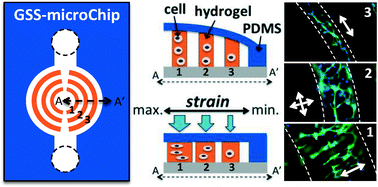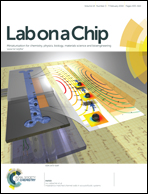Gradient static-strain stimulation in a microfluidic chip for 3D cellular alignment†
Abstract
Cell alignment is a critical factor to govern cellular behavior and function for various tissue engineering applications ranging from cardiac to neural regeneration. In addition to physical geometry, strain is a crucial parameter to manipulate cellular alignment for functional tissue formation. In this paper, we introduce a simple approach to generate a range of gradient static strains without external mechanical control for the stimulation of cellular behavior within 3D biomimetic hydrogel microenvironments. A glass-supported microfluidic chip with a convex flexible polydimethylsiloxane (PDMS) membrane on the top was employed for loading the cells suspended in a prepolymer solution. Following UV crosslinking through a photomask with a concentric circular pattern, the cell-laden hydrogels were formed in a height gradient from the center (maximum) to the boundary (minimum). When the convex PDMS membrane retracted back to a flat surface, it applied compressive gradient forces on the cell-laden hydrogels. The concentric circular hydrogel patterns confined the direction of hydrogel elongation, and the compressive strain on the hydrogel therefore resulted in elongation stretch in the radial direction to guide cell alignment. NIH3T3 cells were cultured in the chip for 3 days with compressive strains that varied from ~65% (center) to ~15% (boundary) on hydrogels. We found that the hydrogel geometry dominated the cell alignment near the outside boundary, where cells aligned along the circular direction, and the compressive strain dominated the cell alignment near the center, where cells aligned radially. This study developed a new and simple approach to facilitate cellular alignment based on hydrogel geometry and strain stimulation for tissue engineering applications. This platform offers unique advantages and is significantly different from the existing approaches owing to the fact that gradient generation was accomplished in a miniature device without using an external mechanical source.


 Please wait while we load your content...
Please wait while we load your content...